From Up on Poppy Hill
7.4 /10 1 Votes
8/10 MyAnimeList 2.5/4 Roger Ebert Genre Animation, Drama, Family Music director Satoshi Takebe | 7.4/10 IMDb 83% Rotten Tomatoes Director Goro Miyazaki Duration | |||||||||||||||||||||||||||||||||
 | ||||||||||||||||||||||||||||||||||
Release date July 17, 2011 (2011-07-17) (Japan) Based on Kokuriko-zaka kara by Chizuru TakahashiTetsuro Sayama Writer Tetsuro Sayama (original story), Hayao Miyazaki (screenplay), Keiko Niwa (screenplay), Chizuru Takahashi (comic), Tetsuro Sayama (comic) Cast (Tokumaru rijichô), (Umi Matsuzaki), Jun'ichi Okada (Shun Kazama), (Hana Matsuzaki), (Miki Hokuto), (Sachiko Hirokôji)Similar movies Spirited Away , , Kiki's Delivery Service , The Secret World of Arrietty , Howl's Moving Castle , Castle in the Sky | ||||||||||||||||||||||||||||||||||
From up on poppy hill official trailer
From Up on Poppy Hill (Japanese: コクリコ坂から, Hepburn: Kokuriko-zaka Kara, "From Coquelicot Hill") is a 2011 Japanese animated drama film directed by Gorō Miyazaki, scripted by Hayao Miyazaki and Keiko Niwa, and produced by Studio Ghibli. It is based on the 1980 serialized Japanese comic of the same name illustrated by Chizuru Takahashi and written by Tetsurō Sayama. The film stars the voices of Masami Nagasawa, Junichi Okada, Keiko Takeshita, Yuriko Ishida, Jun Fubuki, Takashi Naito, Shunsuke Kazama, Nao Ōmori and Teruyuki Kagawa.
Contents
- From up on poppy hill official trailer
- Plot
- Voice cast
- Historical basis
- Production
- Animation
- Voice acting
- Music
- Soundtrack
- Release
- Box office
- Critical reception
- References

Set in 1963 Yokohama, Japan, the film tells the story of Umi Matsuzaki, a high school girl living in a boarding house, Coquelicot Manor. When Umi meets Shun Kazama, a member of the school's newspaper club, they decide to clean up the school's clubhouse, Quartier Latin. However, Tokumaru, the chairman of the local high school and a businessman, intends to demolish the building for redevelopment and Umi and Shun, along with Shirō Mizunuma, must persuade him to reconsider.
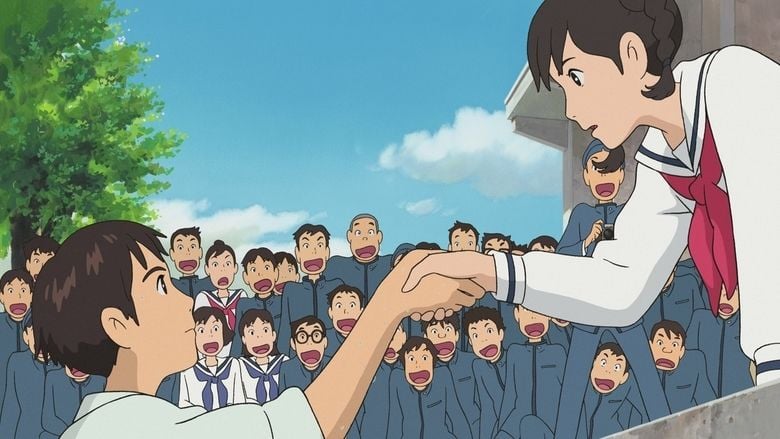
From Up on Poppy Hill premiered on July 16, 2011, in Japan. The film received positive reviews from most film critics and grossed $61 million worldwide. An English version of the film was distributed by GKIDS; it was released to theaters on March 15, 2013, in North America.
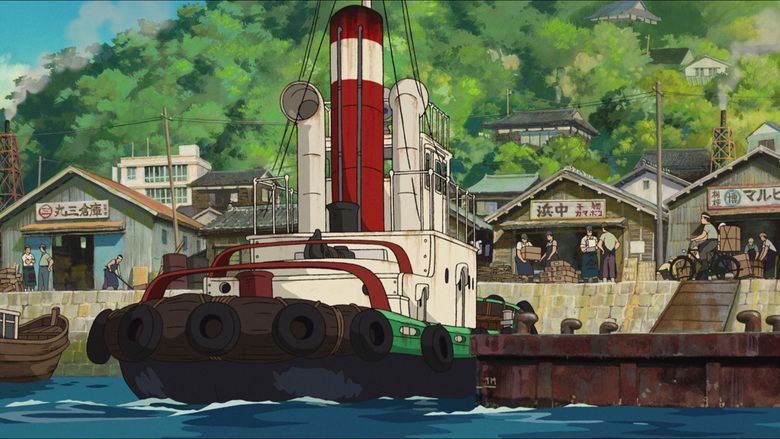
Plot
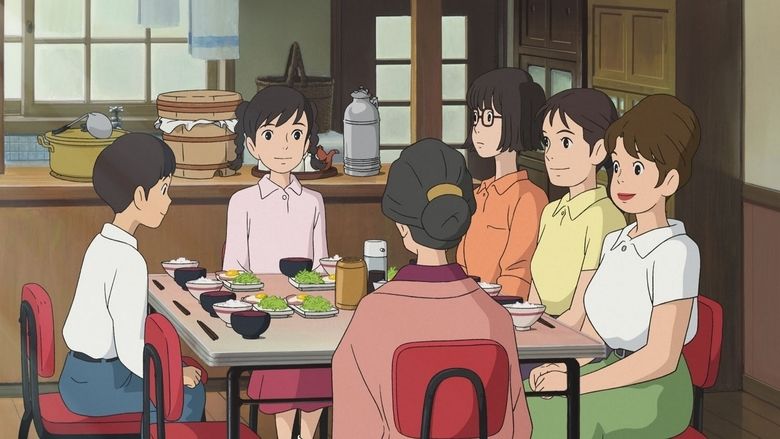
Umi Matsuzaki is a sixteen-year-old student attending Isogo High School living in Coquelicot Manor, a boarding house overlooking the Port of Yokohama in Japan. Her mother, Ryoko, is a medical professor studying abroad in the United States. Umi runs the house and looks after her younger siblings, Sora and Riku, and her grandmother, Hana. College student Sachiko Hirokouji, and doctor-in-training Miki Hokuto, also live there. Each morning, Umi raises a set of signal flags with the message "I pray for safe voyages".
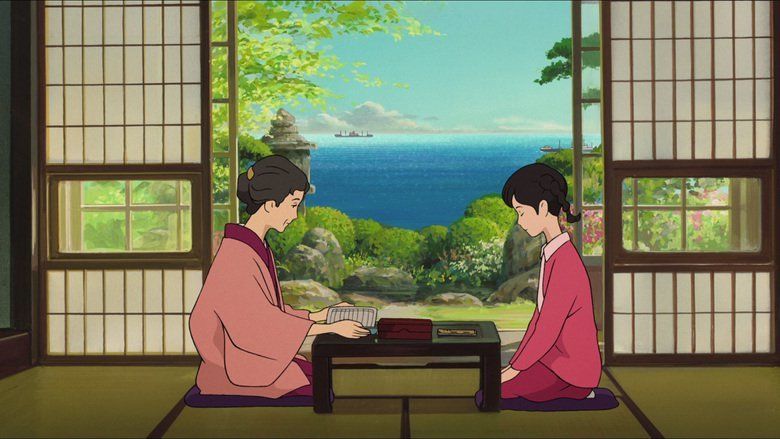
One day, a poem about the flags being raised, is published in the school newspaper. Shun Kazama, the poem's author and a member of the journalism club, witnesses the flags from sea as he rides a tugboat to school. At Isogo High, Umi meets Shun when he participates in a daredevil stunt for the newspaper, leaving Umi with a negative first impression. Umi later accompanies Sora to obtain Shun's autograph at the Quartier Latin, an old and dilapidated building housing Isogo High's clubs. Umi learns that Shun publishes the school newspaper, along with Shirō Mizunuma, Isogo High's student government president. She ends up helping on the newspaper. Later, Shun convinces the other students to renovate the building after a debate on the future of the Quartier Latin, which may be demolished. At Umi's suggestion, the female student body cooperates with the other students.
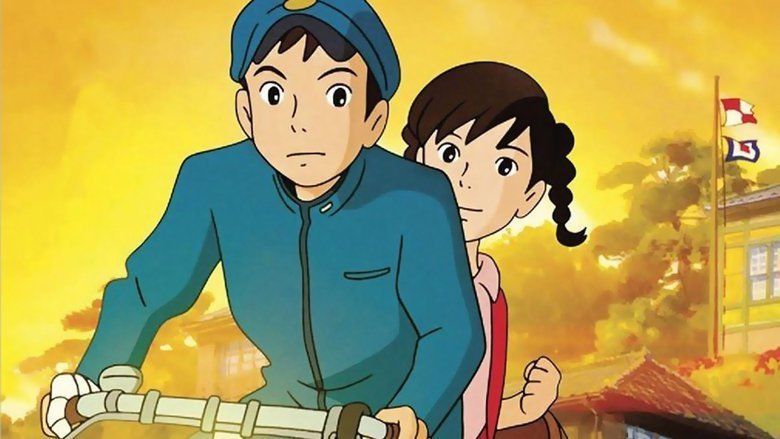
Back at Coquelicot Manor, Umi shows Shun a photograph of three young naval men. One of these men is her deceased father, Yūichirō Sawamura, who was killed in the Korean War. Shun is stunned to see the photograph. At home that night, he opens a notebook to reveal he has a duplicate of Umi's photograph. He questions his father, who reveals that Yūichirō arrived at their house one evening with a young Shun, shortly after the end of World War II. The Kazamas had recently lost their infant, so they adopted Shun. Upon discovering that he is avoiding her, Umi eventually confronts Shun, who reveals they may be siblings. Having checked the city records, Shun discovers that both their names are in the Sawamura family registry. Umi is able to hide her feelings from Shun, and they continue as friends.
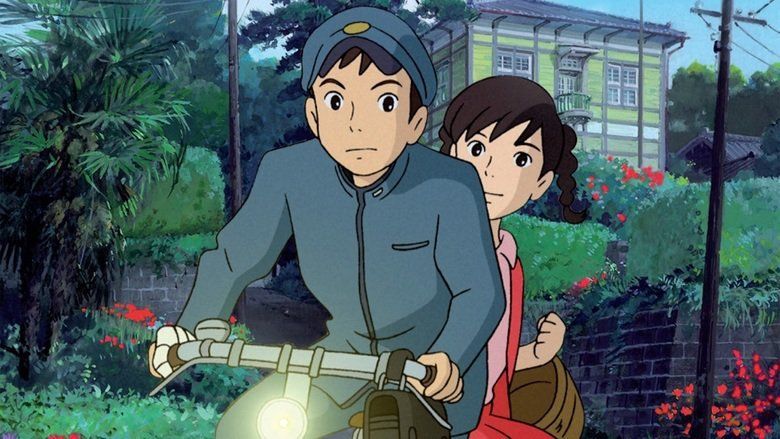
When the renovation of the Quartier Latin is complete, the Kanagawa Prefectural Board of Education decides to proceed with the building's demolition. The students nominate Shun, Umi, and Shirō to visit Tokyo and meet with Tokumaru, a businessman and the school board's chairman. The trio travels through the city, which is in preparation for the 1964 Summer Olympics, and successfully convince Tokumaru to visit the Quartier Latin. As Shirō leaves the group, Umi professes her love to Shun, and he reciprocates her feelings in spite of their situation.

After she returns home, Umi discovers that her mother, Ryoko, has returned. Ryoko reveals that Shun's father was Hiroshi Tachibana — the second man in the photograph. In 1945, Tachibana was killed in an accident on a repatriation ship. Shun's mother died in childbirth, and his other relatives were killed in the atomic bombing of Nagasaki. However, Ryoko was unable to raise Shun, as she was pregnant with Umi during her time as a medical student. Yūichirō registered the child as his own to avoid leaving Shun as an orphan in the confused postwar years, but Shun was eventually given to a local couple, the Kazamas. Umi, however, still has concerns.
Tokumaru visits the Quartier Latin the next day and, impressed by the students' efforts in renovating the building, he decides to cancel the demolition. Umi and Shun are soon summoned to the harbor. They meet Yoshio Onodera, now a ship's captain, who was the third man in the photograph, and the sole survivor of the three. Confirming that Umi and Shun are not related by blood, Onodera tells the full story of the three naval men in the previous era. With everything resolved, Umi returns to Coquelicot Manor and resumes her daily routine of raising the flags.
Voice cast
The cast also includes Director Gorō Miyazaki with the voice of Isogo High School's world history teacher while in English version world history teacher is voiced by Ronan Farrow. Jeff Dunham voices Gen in the English-language version. Ron Howard voices Philosophy Club's president in the English-language version.
Historical basis
In the film, Umi's father was killed when his supply ship was sunk by mines in the Korean War, and Shun's biological father died aboard a repatriation vessel after the end of the Second World War.
Following Japan's defeat in the Second World War, the Supreme Commander for the Allied Powers (SCAP) assumed control over the Japanese merchant marine to return repatriates to their homelands. At the start of the Korean War, those ships, together with their Japanese crews, were pressed into service by the US military to carry forces and supplies to Korea. Japanese vessels played a significant role at the Incheon and Wonsan landings. The shipping firm Tozai Kisen was among the most prominent firms involved, concluding "an agreement with the US military’s Japan Logistical Command (JLC) to provide 122 small vessels and around 1,300 crew for transport and landing work".
According to estimates, 56 Japanese sailors and labourers were killed in the Korean War zone in the first six months of the war alone; 23 of the deaths occurred when Japanese-crewed ships were sunk by mines. Official estimates of the total number of Japanese killed in the Korean War have never been published, nor have the U.S. or Japanese governments officially recognised the role of Japanese non-combatants in the Korean War.
The 1960s saw an escalating increase in student activism and campus revolts in Japan as well as in other parts of the world.
Production
From Up on Poppy Hill was officially revealed as the new Studio Ghibli film for 2011 on December 15, 2010. This film is based on the 1980s shōjo manga of the same name by Tetsuo Sayama and Chizuru Takahashi. It was also revealed the director Gorō Miyazaki would be directing the film. Gorō Miyazaki is the eldest son of Studio Ghibli's co-founder and acclaimed director Hayao Miyazaki, and had made his directorial debut in the 2006 film Tales from Earthsea. From Up on Poppy Hill is his second work. The film is a co-production by its animation studio Studio Ghibli, Nippon Television, Dentsū, Hakuhōdō DY Media Partners, home video distributor Walt Disney Pictures, Mitsubishi Corporation and theatrical distributor Tōhō.
In a press interview given after the 2011 Tōhoku earthquake and tsunami, it was announced the film's production was affected by the rolling blackouts imposed after this disaster. In particular, the animation process was forced to proceed in the night to minimize disruptions. When pressed about the progress of the film, it was revealed that the film's animation was "about 50% completed", though it was also added that the "animation would have otherwise been over 70% completed without the disaster". However, Hayao Miyazaki assured the public that the film would still be released on July 16, 2011, as previously announced, saying that it was their responsibility to do so. Gorō Miyazaki stated that while most of the staff was not affected by the disaster, there were several "who did go through a period of mental affectedness because of what happened and that took some time to recover from."
Gorō Miyazaki initially researched Yokohama, intending to be faithful to the city's historical details. However, after realizing that "simply re-enacting something of the time may seem real enough but may not necessarily be beautiful". Miyazaki decided to show the location as "shimmering and bustling with life" from the viewpoint of the characters. In designing the Quartier Latin, Miyazaki worked with the art directors who added ideas about the "amalgamation of clutter in the house's many rooms" and attempted to "look at the architecture of the building, but to also remember back to my college years and the clutter and filthiness that [Miyazaki] lived through".
Animation
The film's animation directors are Akihiko Yamashita (Suikoden III opening, Howl's Moving Castle, The Secret World of Arrietty), Atsushi Yamagata (InuYasha the Movie, Origin, Brave Story) and Kitarō Kōsaka and its most-known key animators include Makiko Futaki, Shinji Ōtsuka, Takeshi Honda, Takashi Hashimoto, Hideki Hamasu, Atsuko Tanaka, The Secret World of Arrietty director Hiromasa Yonebayashi and Hiroyuki Aoyama.
Voice acting
The main voice cast members were officially unveiled on May 13, 2011. It was announced that actress Masami Nagasawa would voice Matsuzaki, the film's main high school character. This was Nagasawa's first voice acting role in a Studio Ghibli film. In addition, Jun'ichi Okada, a member of the Japanese band V6, would be voicing Shun Kazama, who is a member of the school newspaper publishing team. Additionally, Jun Fubuki, Keiko Takeshita, Takashi Naitō, Teruyuki Kagawa, Yuriko Ishida, Nao Ōmori and Shunsuke Kazama would voice other minor characters in the film.
In June 2012, it was announced that a North American dub would be recorded and that it was being executive-produced by Kathleen Kennedy and Frank Marshall, written by Karey Kirkpatrick and directed by Gary Rydstrom. The cast members of the dub include Sarah Bolger, Anton Yelchin, Ron Howard, Jeff Dunham, Gillian Anderson, Chris Noth, Ronan Farrow, Isabelle Fuhrman, Emily Osment, Charlie Saxton, Alex Wolff, Beau Bridges, Jamie Lee Curtis, Bruce Dern, Christina Hendricks, Elisa Gabrielli and Aubrey Plaza.
Music
The film score of From Up on Poppy Hill was composed by Satoshi Takebe. In December 2010, it was announced that singer Aoi Teshima would sing the film's theme song, "Summer of Farewells — From Up on Poppy Hill" (「さよならの夏~コクリコ坂から~」, "Sayonara no Natsu ~Kokuriko-zaka kara~").
The 1961 song "I Shall Walk Looking Up" (「上を向いて歩こう」, "Ue o Muite Arukō"), better known in English-speaking countries as "Sukiyaki" and performed by Kyu Sakamoto, is included in this film as one of its insert songs. The instrumental version of this song was later released in the United States under the title of "Sukiyaki" by musician Kenny Ball. This song was chosen for the film because From Up on Poppy Hill is set in the year 1963, the same year that this song debuted and became a hit in America.
Soundtrack
The soundtrack album was released by Tokuma Japan Communications on July 13, 2011. It contains the film score to From Up On Poppy Hill, as well as six insert songs and the film's theme song.
Release
From Up on Poppy Hill was released in Japanese cinemas on July 16, 2011. It debuted at third placing in the Japanese box office, behind films Harry Potter and the Deathly Hallows – Part 2 and the dual-release Pokémon anime film Victini and the Black Hero: Zekrom and Victini and the White Hero: Reshiram. It managed to gross approximately 587 million yen and attracted around 450,000 viewers. Furthermore, an art exhibition, entitled THE ART OF From Up On Poppy Hill was held to coincide with the film's release. This exhibition featured more than 130 art and storyboards used in the making of this film, and it was held from July 23 to 28, 2011 in the Seibu Ikebukuro Main Store in Tokyo. The exhibition was later moved to Sogo's Yokohama Branch Store from August 10 to 15, 2011.
The movie was released in France on January 11, 2012, as La Colline aux coquelicots by Walt Disney Pictures. It gathered over 287,281 viewers in its four weeks of exhibition far more than Tales from Earthsea (in 2007, with 143,641 viewers).
On August 17, 2011, it was announced the film From Up on Poppy Hill would be one of the Japanese films being showcased at the 2011 Toronto International Film Festival, which was held from September 8 to 18, 2011. It was also revealed that the film would be showcased in the "Japan International Premiere" section, which is part of the "Contemporary World Cinema" event in the festival.
The film received a limited theatrical release in North America on March 15, 2013. An English dub was recorded for this release directed by Gary Rydstrom and produced by The Kennedy/Marshall Company, who also oversaw the English dubs for Ponyo and The Secret World of Arrietty. The release was licensed by Studio Ghibli to GKIDS, which marked the first time a Studio Ghibli film was not distributed by Walt Disney Studios Motion Pictures in North America since the 1999 North American release of Princess Mononoke by then-Disney owned Miramax Films. On September 23, 2013, a Blu-ray edition of the film was released in the United Kingdom by StudioCanal.
Box office
During the survey period between July 16–18, 2011, Bunkatsushin.com reported From Up on Poppy Hill had grossed 587,337,400 yen at the box office, placing third. During these three days, over 445,000 people watched this film. In a survey which was done online and on mobile platforms, it was revealed the ratio of female audience to male audience was 57% to 43%. By age, 34.8% of the audience were in their twenties, 18.9% of them were aged between 16 and 19 years old, and people who were aged over 30 made up 32.6% of the audience. This film crossed the 3 billion yen gross mark during the weekend of August 21–22, 2011.
From Up on Poppy Hill earned $1,002,895 in North America and $60,456,530 in other territories for a worldwide total of $61,459,425. It is the 14th highest-grossing anime film. Between Grave of the Fireflies, Only Yesterday, Ocean Waves, Whisper of the Heart and My Neighbors the Yamadas, From Up on Poppy Hill is the highest grossing Ghibli film about specialising in Japanese local customs, behind The Wind Rises, and its 7th best grossing one of the Ghibli films in United States.
In France, the film was well received by the public. It gathered over 287,281 viewers in its four weeks of exhibition far more than Tales from Earthsea (in 2007, with 143,641 viewers).
Critical reception
From Up on Poppy Hill received generally positive reviews from film critics; Rotten Tomatoes sampled 83 reviews and judged 84% of them to be positive with an average rating of 7/10, and the consensus: "Gentle and nostalgic, From Up on Poppy Hill is one of Studio Ghibli's sweeter efforts—and if it doesn't push the boundaries of the genre, it remains as engagingly lovely as Ghibli fans have come to expect". Metacritic, which assigns a weighted average score, rated the film 71 out of 100 based on 20 reviews.
Mark Schilling of The Japan Times described From Up on Poppy Hill as a "pure-hearted, melodramatic youth film". The reviewer criticized the story as "predictable" and called the film's direction "pedestrian". However, he concluded the review by praising the film, saying "a wealth of period detail brings the era to nostalgic/realistic life". Takashi Kondo of The Daily Yomiuri said that the film "is filled with many experiences that have been lost in our daily life". Kondo also said that "the father-son joint production [of Hayao and Gorō Miyazaki] achieved a wonderful result and [From Up on Poppy Hill] is a work that needs to be seen in this day and age".
A. O. Scott of The New York Times praised From Up on Poppy Hill for its visuals as well as its characterization. Although Scott said that the "specific tragedy that lies in the background may not register with children," he would say that adults are "likely to be charmed by the love story and enchanted by the delicate rendering of a bygone but not entirely forgotten era". Kenneth Turan of the Los Angeles Times called the film "a time-machine dream of a not-so-distant past, a sweet and honestly sentimental story that also represents a collaboration between the greatest of Japanese animators and his up-and-coming son." Turan also said that Latin Quarter "is "Poppy Hill" at its most fantastical." On the characterizations, Turan stated, "the respect and politeness with which all the characters, even the teenage protagonists, treat one another is a far cry from what can go on in this day and age."
In France, the film was favorably received by the press although the script and animation were judged to be slightly lacking by some.
References
From Up on Poppy Hill WikipediaFrom Up on Poppy Hill IMDbFrom Up on Poppy Hill MyAnimeList.netFrom Up on Poppy Hill Rotten TomatoesFrom Up on Poppy Hill Roger EbertFrom Up on Poppy Hill themoviedb.org
